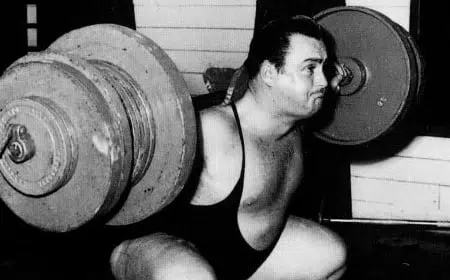According to many fitness experts, you need to follow a complex routine and use advanced training methods to pack on mass and build strength. You’ll also need access to a state-of-the-art gym, take supplements by the truckload, and follow a carefully planned diet.
However, the reality is that people have been getting big and strong for centuries, and without the complex methods that today’s fitness industry considers essential.
Despite their lack of sophisticated training methods, old-school lifters built huge muscles and incredible strength by embracing the basics. They worked hard, ate healthily, got plenty of rest and sleep, and didn’t get hung up on the minutia of training.
There are lots of examples of this “basics is best” approach to strength training, including the classic 20-rep squat program, Arnold Schwarzenegger’s Golden Six Routine, and Sig Klein’s full-body workout plan. Each of these programs has stood the test of time and helped thousands of lifters get bigger and stronger.
The Hepburn Method is another fantastic example of how simple strength training can deliver impressive results. In this article, I explore the Hepburn Method, explain how it works, and provide you with a straightforward, results-guaranteed workout plan to try.
Who Was Doug Hepburn?
Doug Hepburn (September 16, 1926 – November 22, 2000) was a Canadian Olympic weightlifter, powerlifter, strongman, and professional wrestler. A true heavyweight, Hepburn tipped the scales at over 300 lbs. and was, during the 1950s, rated as the strongest man in the world.
Level Up Your Fitness: Join our 💪 strong community in Fitness Volt Newsletter. Get daily inspiration, expert-backed workouts, nutrition tips, the latest in strength sports, and the support you need to reach your goals. Subscribe for free!

Hepburn had a long, memorable lifting career, but a few highlights include:
- First man to bench press 500 pounds
- First man to clean and press 400 pounds
- Winner of the gold medal at the 1953 World Weightlifting Championships
- Inducted into the Canadian Sports Hall of Fame in 1955
- Squatted 600 pounds at the age of 54
- Unbeaten in all strength competitions during his prime
Despite his incredible achievements, Doug Hepburn relied on a very simple and methodical approach to training. In the next section, we’ll dive into the Hepburn Method, exploring the principles and practices that Hepburn used to build his phenomenal strength.
Hepburn Method Basics
The Hepburn Method involves a very simple form of progressive overload. In other words, each workout is slightly harder than the one that preceded it. Studies suggest that progressive overload is one of the most critical factors for effective strength and muscle building (1).
However, Hepburn didn’t increase workout difficulty randomly or in large jumps. Instead, he built strength and mass by adding just one rep per workout. Over time, these small additions produced huge increases in performance and muscle size.
The Hepburn Method revolves around two main set/rep schemes:
- 6 sets of 2-3 reps with 80% of your 1RM
- 3 sets of 6-8 reps with 60% of your 1RM
These set/rep schemes are then applied to just a small number of compound exercises per workout, e.g., squats, deadlifts, bench presses, overhead presses, rows, and pulldowns. But, for each workout, you add one rep per set to gradually increase training difficulty.
Here’s what an eight-week Hepburn Method training cycle should look like.
Week 1
2/2/2/2/2/2
6/6/6
Week 2
3/2/2/2/2/2
7/6/6
Week 3
3/3/2/2/2/2
7/7/6
Week 4
3/3/3/2/2/2
7/7/7
Week 5
3/3/3/3/2/2
8/7/7
Week 6
3/3/3/3/3/2
8/8/7
Week 7
3/3/3/3/3/3
8/8/8
Week 8
Increase your weights by 10lbs/5kg and start over
The Hepburn Method is meant for the long haul – this ain’t no get big quick program! However, if you follow it for 12 months, adding just 10 pounds per lift per month, you’ll be significantly stronger and more muscular by the end of the year.
Sample Hepburn Method Workout
Doug Hepburn used many workout programs throughout his career. However, they all used a similar set/rep scheme while focusing on a few key compound lifts. So, with that in mind, and based on my 30-plus years of personal training experience, here is my Hepburn-inspired training plan.
You’ll be doing each workout twice a week but with an alternating set/rep scheme. Add one rep per workout per week in line with the Hepburn progression method described above.
Use this calculator to determine your one repetition maximum (1RM) to establish your starting weights for the entire training cycle. Don’t worry if the weights feel a little light at first – as the weeks pass and you start to add reps, the workouts will gradually become more challenging.
Level Up Your Fitness: Join our 💪 strong community in Fitness Volt Newsletter. Get daily inspiration, expert-backed workouts, nutrition tips, the latest in strength sports, and the support you need to reach your goals. Subscribe for free!
However, before you start any of these workouts, make sure you prepare your muscles and joints with an appropriate warm-up. Do 5-10 minutes of light cardio followed by dynamic mobility and flexibility for the body parts you are about to train.
Monday
- Squat 6 sets of 2 reps @ 80% 1RM
- Deadlift 3 sets of 6 reps @ 60% 1RM
- Leg extensions/leg curls 2-3 sets of 8-12 reps (optional)
- 1-2 core exercises of your choice
Tuesday
- Bench press reps 6 sets of 2 reps @ 80% 1RM
- Weighted pull-up 6 sets of 2 reps @ 80% 1RM
- Overhead press 3 sets of 6 reps @ 60% 1RM
- Pendlay rows 3 sets of 6 reps @ 60% 1RM
- Biceps/triceps 2-3 sets of 8-12 reps (optional)
Thursday
- Deadlift 6 sets of 2 reps @ 80% 1RM
- Squats 3 sets of 6 reps @ 60% 1RM
- Leg extensions/leg curls 2-3 sets of 8-12 reps (optional)
- 1-2 core exercises of your choice
Friday
- Overhead press 6 sets of 2 reps @ 80% 1RM
- Pendlay rows 6 sets of 2 reps @ 80% 1RM
- Bench reps 3 sets of 6 reps @ 60% 1RM
- Weighted pull-up 3 sets of 6 reps @ 60% 1RM
- Biceps/triceps 2-3 sets of 8-12 reps (optional)
Rest 2-3 minutes between 80% sets and 90 seconds between 60% sets. Feel free to superset push and pull exercises on upper body days to save time. They’re already arranged in pairs for this reason.
Related: How to Warm Up for Strength Training
Hepburn Method Pros and Cons
Is the Hepburn Method right for you? Consider these pros and cons before trying this classic strength-building program for yourself.
Pros
Predictable Progress – once you have determined your starting weights, all you need to do is one extra rep per workout to make progress. Using a spreadsheet, you should be able to predict how much stronger you’ll be in three, six, or even 12 months. This can be very motivating and takes a lot of the guesswork out of training for strength.
Minimal equipment required – Doug Hepburn did most of his training with barbells and dumbbells. And yet, despite this lack of fancy equipment, he eventually became the strongest man of his generation. This proves that you don’t need a state-of-the-art gym to become a strength legend. Rather, you just need dedication and perseverance.
A gradual increase in workout difficulty – doing two reps per set with 80% of your 1RM and six reps per set with 60% should feel very manageable. This easy start and gradual increase in difficulty helps build momentum and confidence so that, when things become more challenging, you’ll feel more than ready to work harder.
Build strength and mass simultaneously – the two rep ranges used in the Hepburn Method develop muscle strength and size at the same time. As such, this is an early example of what is now known as powerbuilding.
Versatile – you can apply Hepburn’s form of progressive overload to almost any strength or muscle-building program or exercise, even calisthenic movements like push-ups and pistol squats. Just add a rep per workout per week and, a year from now, you’ll be much stronger and more muscular.
Cons
A very slow build-up – the Hepburn Method takes several weeks and even a month or two before the weights will start to feel challenging. You may even think that the first few workouts are too easy to be effective. As such, some lifters lose confidence in the program early on. But, stick with it, and you will be rewarded!
Repetitive workouts – some people find doing the same exercises twice per week somewhat repetitive or even boring. This is especially true for anyone used to following a more varied program or who uses the “muscle confusion” principle. However, it’s important to note that exercise variation is not necessary for building strength and mass.
Not a bodybuilding program – while the Hepburn program will increase muscle size, this is just a side effect of getting stronger and increasing your performance in the prescribed lifts. Some muscles, such as the medial deltoids, calves, trapezius, etc., are not trained directly, which may affect aesthetics and muscle balance.
Requires accurate record keeping – success with the Hepburn Method hinges on adding one rep per workout. Failure to do so will undermine your progress. As such, you’ll need to record your workouts, so you know how many reps you’ve done and how many you need to do next time. Some exercisers may find this record-keeping inconvenient or annoying.
Hepburn Method FAQs
Do you have a question about the Hepburn Method or my Hepburn-inspired training program? No problem, because I’ve got the answers! But, if you need more information, please drop me a line in the comments section below, and I’ll get back to you ASAP.
1. How long should I use the Hepburn method?
The Hepburn Method is NOT a quick-fix program. Instead, it’s meant to be used for many months and even a year or more. Plan on using it for at least six months so that it has time to work its magic. Continue on this program until you are unable to add a rep per week or increase your weights.
2. Do I have to increase my weights by the same amount each cycle?
Initially, you should have no problem increasing your weights by 10lbs/5kg per training cycle. However, after a few months of consistent training, such a jump may be too big, so feel free to add just 5lbs/2.5kg. You may also find that you can add more weight to some lifts than others, e.g., squats vs. overhead presses.
3. Can I change the exercises in the sample workout?
Feel free to change the exercises based on your needs and goals. However, use similar movements to maintain the spirit of the program. For example, doing floor presses instead of bench presses is an acceptable swap, but replacing squats with lunges is not.
You can also add supplementary exercises if you wish, e.g, face pulls for your rear deltoids, but never at the expense of your main lifts.
4. Is this a cutting or a bulking program?
The Hepburn method works best when you have a kilocalorie surplus, i.e., you are consuming more kilocalories than you need to maintain your weight. Your body will use this extra energy to fuel your workouts and build muscle.
Not eating enough will undermine your progress and could stop you from adding reps or weight to your workouts. Long story short, this is a bulking and not a cutting program.
5. How does cardio fit into the Hepburn Method?
While you can do cardio on your rest days and after upper body training, you should avoid doing so much that it interferes with recovery or subsequent workouts. 20-30 minutes of cardio 3-4 times per week will be enough to maintain and improve cardiorespiratory fitness and health without compromising your gains.
Related: Unlocking the Benefits of Zone 2 Training
Conclusion
You don’t need complicated workout programs, sophisticated equipment, or expensive supplements to get bigger and stronger. Instead, all you really need is a simple program and a willingness to do just one more rep per week. Although your progress will be slow and steady, one year from now you’ll be significantly stronger and more muscular.
While such a slow-burn approach requires patience, it’s a proven method for building incredible strength.
Not convinced? Just ask Doug Hepburn – the first man in history to bench press 500 pounds!
References:
- Peterson MD, Pistilli E, Haff GG, Hoffman EP, Gordon PM. Progression of volume load and muscular adaptation during resistance exercise. Eur J Appl Physiol. 2011 Jun;111(6):1063-71. doi: 10.1007/s00421-010-1735-9. Epub 2010 Nov 27. PMID: 21113614; PMCID: PMC4215195.










